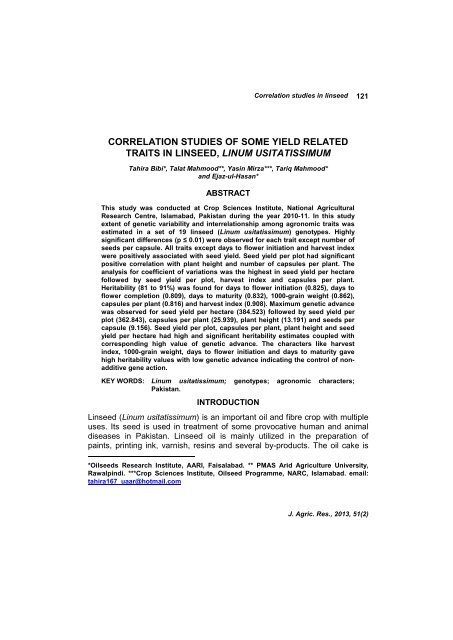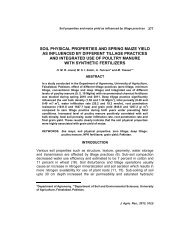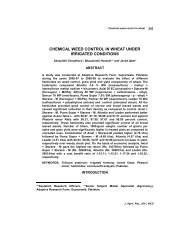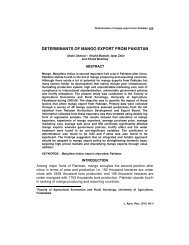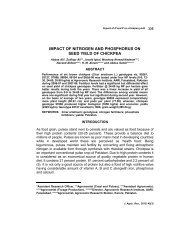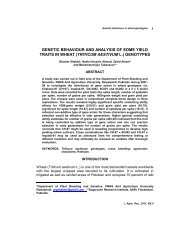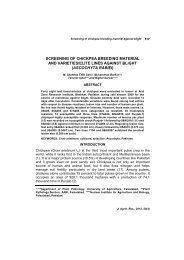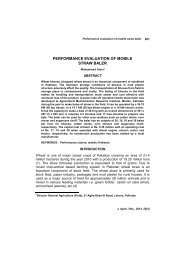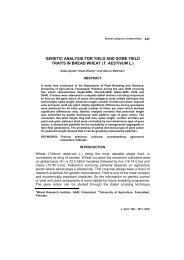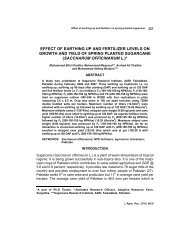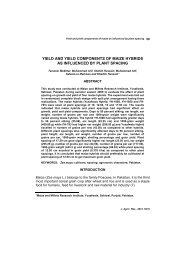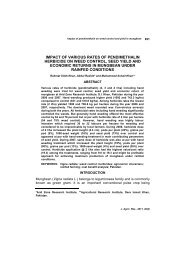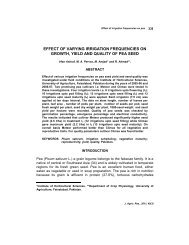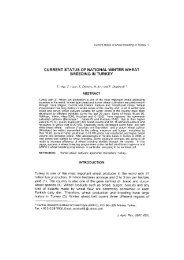correlation studies of some yield related traits in linseed, linum ...
correlation studies of some yield related traits in linseed, linum ...
correlation studies of some yield related traits in linseed, linum ...
Create successful ePaper yourself
Turn your PDF publications into a flip-book with our unique Google optimized e-Paper software.
Correlation <strong>studies</strong> <strong>in</strong> l<strong>in</strong>seed<br />
121<br />
CORRELATION STUDIES OF SOME YIELD RELATED<br />
TRAITS IN LINSEED, LINUM USITATISSIMUM<br />
Tahira Bibi*, Talat Mahmood**, Yas<strong>in</strong> Mirza***, Tariq Mahmood*<br />
and Ejaz-ul-Hasan*<br />
ABSTRACT<br />
This study was conducted at Crop Sciences Institute, National Agricultural<br />
Research Centre, Islamabad, Pakistan dur<strong>in</strong>g the year 2010-11. In this study<br />
extent <strong>of</strong> genetic variability and <strong>in</strong>terrelationship among agronomic <strong>traits</strong> was<br />
estimated <strong>in</strong> a set <strong>of</strong> 19 l<strong>in</strong>seed (L<strong>in</strong>um usitatissimum) genotypes. Highly<br />
significant differences (p ≤ 0.01) were observed for each trait except number <strong>of</strong><br />
seeds per capsule. All <strong>traits</strong> except days to flower <strong>in</strong>itiation and harvest <strong>in</strong>dex<br />
were positively associated with seed <strong>yield</strong>. Seed <strong>yield</strong> per plot had significant<br />
positive <strong>correlation</strong> with plant height and number <strong>of</strong> capsules per plant. The<br />
analysis for coefficient <strong>of</strong> variations was the highest <strong>in</strong> seed <strong>yield</strong> per hectare<br />
followed by seed <strong>yield</strong> per plot, harvest <strong>in</strong>dex and capsules per plant.<br />
Heritability (81 to 91%) was found for days to flower <strong>in</strong>itiation (0.825), days to<br />
flower completion (0.809), days to maturity (0.832), 1000-gra<strong>in</strong> weight (0.862),<br />
capsules per plant (0.816) and harvest <strong>in</strong>dex (0.908). Maximum genetic advance<br />
was observed for seed <strong>yield</strong> per hectare (384.523) followed by seed <strong>yield</strong> per<br />
plot (362.843), capsules per plant (25.939), plant height (13.191) and seeds per<br />
capsule (9.156). Seed <strong>yield</strong> per plot, capsules per plant, plant height and seed<br />
<strong>yield</strong> per hectare had high and significant heritability estimates coupled with<br />
correspond<strong>in</strong>g high value <strong>of</strong> genetic advance. The characters like harvest<br />
<strong>in</strong>dex, 1000-gra<strong>in</strong> weight, days to flower <strong>in</strong>itiation and days to maturity gave<br />
high heritability values with low genetic advance <strong>in</strong>dicat<strong>in</strong>g the control <strong>of</strong> nonadditive<br />
gene action.<br />
KEY WORDS: L<strong>in</strong>um usitatissimum; genotypes; agronomic characters;<br />
Pakistan.<br />
INTRODUCTION<br />
L<strong>in</strong>seed (L<strong>in</strong>um usitatissimum) is an important oil and fibre crop with multiple<br />
uses. Its seed is used <strong>in</strong> treatment <strong>of</strong> <strong>some</strong> provocative human and animal<br />
diseases <strong>in</strong> Pakistan. L<strong>in</strong>seed oil is ma<strong>in</strong>ly utilized <strong>in</strong> the preparation <strong>of</strong><br />
pa<strong>in</strong>ts, pr<strong>in</strong>t<strong>in</strong>g <strong>in</strong>k, varnish, res<strong>in</strong>s and several by-products. The oil cake is<br />
*Oilseeds Research Institute, AARI, Faisalabad. ** PMAS Arid Agriculture University,<br />
Rawalp<strong>in</strong>di. ***Crop Sciences Institute, Oilseed Programme, NARC, Islamabad. email:<br />
tahira167_uaar@hotmail.com<br />
J. Agric. Res., 2013, 51(2)
122<br />
T. Bibi et al.<br />
the most valuable feed<strong>in</strong>g cake for animals. L<strong>in</strong>seed has also great medic<strong>in</strong>al<br />
values <strong>in</strong>clud<strong>in</strong>g anti-hyper cholesterolemic and anti-carc<strong>in</strong>ogenic effects and<br />
is also beneficial for development <strong>of</strong> bra<strong>in</strong> and ret<strong>in</strong>al tissues <strong>of</strong> <strong>in</strong>fants (23).<br />
Pakistan is produc<strong>in</strong>g 2779 tons <strong>of</strong> l<strong>in</strong>seed from an area <strong>of</strong> 4018 hectares<br />
with an average <strong>yield</strong> <strong>of</strong> 692 kg per hectare (5). In Pakistan, the potential <strong>of</strong><br />
crop is not be<strong>in</strong>g exploited satisfactorily due to many constra<strong>in</strong>ts like<br />
<strong>in</strong>appropriate nutrients supply (3). Harvest<strong>in</strong>g is also a major problem with<br />
l<strong>in</strong>seed and particularly if it is late, <strong>in</strong>completely desiccated or lodged.<br />
Selection for high seed <strong>yield</strong><strong>in</strong>g genotypes is difficult because it is controlled<br />
by multiple <strong>traits</strong> that are highly <strong>in</strong>fluenced by environment. Due to these<br />
factors, success rate <strong>of</strong> selection procedure is low. Indirect selection through<br />
<strong>yield</strong> component has been proved more effective (9). This selection criterion<br />
takes <strong>in</strong>to account the <strong>in</strong>formation on extent and nature <strong>of</strong> <strong>in</strong>terrelationship<br />
among agronomic <strong>traits</strong> and also their relationship with seed <strong>yield</strong>. However,<br />
selection for <strong>yield</strong> via highly cor<strong>related</strong> characters becomes easy.<br />
Genetic <strong>traits</strong> such as coefficient <strong>of</strong> variations, heritability and genetic<br />
advance provide precise estimate <strong>of</strong> genetic variation <strong>of</strong> quantitative <strong>traits</strong><br />
(13, 14, 15). Equipped with such <strong>in</strong>formation, a breeder can formulate<br />
efficient scheme <strong>of</strong> multiple trait selection.<br />
Estimation <strong>of</strong> genotypic and phenotypic variances, coefficients <strong>of</strong> genotypic<br />
and phenotypic variation, heritability and genetic advance provide precise<br />
estimates <strong>of</strong> genetic variability <strong>of</strong> quantitative characters (21, 25). Studies <strong>of</strong><br />
character association may supply more reliable <strong>in</strong>formation on the nature and<br />
level <strong>of</strong> <strong>in</strong>terrelationships <strong>of</strong> l<strong>in</strong>seed <strong>yield</strong> with its <strong>yield</strong> components. Economic<br />
characters such as seed <strong>yield</strong> are controlled by many genes, and has a<br />
complex type <strong>of</strong> <strong>in</strong>heritance (24).<br />
Genotypic coefficient <strong>of</strong> variation helps measure the range <strong>of</strong> genetic<br />
variability <strong>in</strong> a character and provides a way to compare the genetic variation<br />
<strong>in</strong> quantitative <strong>traits</strong> (12). Heritability is the only useful genetic parameter for<br />
predict<strong>in</strong>g direct and cor<strong>related</strong> response (7). Relative amount <strong>of</strong> heritable<br />
portion <strong>of</strong> variation can be assessed through estimation <strong>of</strong> heritability.<br />
However, <strong>some</strong> time high heritability is not <strong>in</strong>dicative <strong>of</strong> high genetic advance.<br />
Therefore, various researchers like Johanson et al. (10) have suggested that<br />
high heritability should be comb<strong>in</strong>ed with genetic advance <strong>in</strong> the prediction <strong>of</strong><br />
phenotypic expression <strong>of</strong> a trait, <strong>in</strong>stead heritability estimates alone, whereas<br />
low heritability <strong>of</strong> a trait proves its stability as desirable genetic parameters<br />
(18).<br />
J. Agric. Res., 2013, 51(2)
Correlation <strong>studies</strong> <strong>in</strong> l<strong>in</strong>seed<br />
123<br />
The present study was conducted to f<strong>in</strong>d association among <strong>yield</strong> and <strong>yield</strong><br />
<strong>related</strong> <strong>traits</strong> <strong>in</strong> l<strong>in</strong>seed that may be helpful <strong>in</strong> selection <strong>of</strong> genotypes.<br />
MATERIALS AND METHODS<br />
This study was conducted at Crop Sciences Institute, National Agricultural<br />
Research Centre, Islamabad, Pakistan dur<strong>in</strong>g the year 2010-11. N<strong>in</strong>eteen<br />
l<strong>in</strong>seed genotypes viz. LS-1, LS-2, LS-3, LS-4, LS-8, LS-11, LS-12, LS-13,<br />
LS-14, LS-17, LS-19, LS-24, LS-25, LS-26, LS-30, LS-31, LS-32 and LS-33<br />
<strong>in</strong>clud<strong>in</strong>g one check variety (Chandni). The experiment was planted <strong>in</strong> RCBD<br />
with three replications. Each experimental unit comprised four rows and plot<br />
size was 5 m x 0.45 m. Plant to plant distance was kept as 10 cm. Data were<br />
recorded for days to flower <strong>in</strong>itiation, days to flower completion, days to<br />
maturity, plant height (cm), number <strong>of</strong> branches per plant, number <strong>of</strong><br />
capsules per plant, number <strong>of</strong> seeds per capsule, 1000-seed weight (g) and<br />
harvest <strong>in</strong>dex (%) from five randomly selected plants <strong>in</strong> each plot. Seed <strong>yield</strong><br />
per plot and seed <strong>yield</strong> per hectare was calculated from whole plot. Data<br />
recorded were subjected to analysis <strong>of</strong> variance as described by Steel and<br />
Torrie (27). Subsequently genotypic and phenotypic variances, heritability<br />
(h 2 ), genetic advance (GA), genotypic coefficient <strong>of</strong> variations (GCV), and<br />
phenotypic coefficient <strong>of</strong> variations (PCV) were worked out follow<strong>in</strong>g Al-<br />
Jibouri et al. (4). Variance and covariance components were estimated by<br />
equat<strong>in</strong>g observed mean squares to their expectations accord<strong>in</strong>g to S<strong>in</strong>gh<br />
and Chaudhary (26). The characters with significant mean squares values<br />
were subjected to Duncan multiple range test (DMRT) for their comparison.<br />
RESULTS AND DISCUSSION<br />
Highly significant differences (p ≤ 0.01) were observed for each trait studied<br />
except number <strong>of</strong> seeds per capsule. It <strong>in</strong>dicated presence <strong>of</strong> significant<br />
variability for effective selection to identify potential genotypes. The mean<br />
squares <strong>of</strong> all the characters analyzed are presented <strong>in</strong> Table 1.<br />
For days to flower <strong>in</strong>itiation, LS-3 and LS-30 were found earlier (108 days<br />
each) whereas LS-17 completed their flower<strong>in</strong>g <strong>in</strong> about 155 days as<br />
compared to check (160 days) (Table 2). The genotype LS-17 matured <strong>in</strong><br />
181 days that significantly differed from check variety. Similarly number <strong>of</strong><br />
branches per plant ranged from 5-7 show<strong>in</strong>g genetic differences among the<br />
genotypes <strong>in</strong>dicat<strong>in</strong>g potential for improvement. Number <strong>of</strong> capsules per<br />
plant ranged from 62 to 12 <strong>in</strong> LS-17 and LS-1, respectively. All genotypes<br />
J. Agric. Res., 2013, 51(2)
124<br />
T. Bibi et al.<br />
Table 1. Mean square values for various <strong>yield</strong> <strong>related</strong> <strong>traits</strong> <strong>of</strong> l<strong>in</strong>seed genotypes dur<strong>in</strong>g<br />
Rabi 2010-11.<br />
S.O.V d.f Days to<br />
flower<br />
<strong>in</strong>itiation<br />
Days to<br />
flower<br />
completion<br />
Days to<br />
maturity<br />
Plant<br />
height (cm)<br />
No. <strong>of</strong><br />
branches/<br />
plant<br />
No. <strong>of</strong><br />
capsules/<br />
plant<br />
Replications 2 2.30 0.5 2.02** 34.67 0.11 264.5**<br />
Genotypes 18 10.59** 9.06** 9.69** 200.76** 1.02** 627.25**<br />
Error 36 0.71 0.66 0.607 25.08 0.10 43.97<br />
LSD (5%) 1.29 1.51 1.20 8.29 0.60 13.02<br />
No. <strong>of</strong> seeds<br />
capsule<br />
1000-gra<strong>in</strong><br />
weight (g)<br />
Harvest<br />
<strong>in</strong>dex (%)<br />
Seed <strong>yield</strong>/<br />
plot(g)<br />
Seed <strong>yield</strong>/ha<br />
(kg)<br />
911.41 2.31** 5.81** 98948.91** 48567.17<br />
1036.37 1.57** 22.04** 119064.22** 183405.58**<br />
622.31 0.080 0.73 7423.81 26324.87<br />
0.38 1.19 1.45 119.72 166.40<br />
** Significant at 1 % level <strong>of</strong> probability.<br />
showed significant variations for number <strong>of</strong> seeds per capsule and LS-33 and<br />
LS-11 had maximum value (9 seeds) aga<strong>in</strong>st check variety (8 seeds) which<br />
was statistically significant (Table 2). 1000-gra<strong>in</strong> weight also depicted large<br />
and dependable genetic variation for its improvement. LS-12 and LS-25 were<br />
found as bold seeded with seed weight <strong>of</strong> 9 g as aga<strong>in</strong>st check (7 g). Harvest<br />
<strong>in</strong>dex ranged from 12-22 percent <strong>in</strong>dicat<strong>in</strong>g large genetic variation. LS-19<br />
was found with maximum harvest <strong>in</strong>dex (22%).<br />
Seed <strong>yield</strong> is an important quantitative trait <strong>in</strong> l<strong>in</strong>seed. It showed statistically<br />
significant genetic differences. Maximum <strong>yield</strong> (1439 kg/ha) was recorded <strong>in</strong><br />
LS-30 followed by LS-4 (1400 kg) (Table 2). The data <strong>in</strong>dicated that LS-1,<br />
LS-3, LS-11, LS-13, LS-14 and LS-25 showed significant <strong>in</strong>crease <strong>in</strong> <strong>yield</strong> i.e<br />
1245, 1339, 1342, 1250, 1352 and 1346 kg per hectare, respectively as<br />
compared to check (1062 kg/ha).<br />
Genetic parameters<br />
The progress <strong>of</strong> breed<strong>in</strong>g for such economic <strong>traits</strong> is determ<strong>in</strong>ed by<br />
magnitude and nature <strong>of</strong> their genotypic and phenotypic variability. Genotypic<br />
variances for all the characters ranged from 0.3 (branches/plant) to 52360.24<br />
kg (seed <strong>yield</strong>/ha) (Table 3), while the phenotypic variance estimates ranged<br />
from 0.4 (branches/plant) to 78685.11 kg (seed <strong>yield</strong>/ha). Similar f<strong>in</strong>d<strong>in</strong>gs <strong>in</strong><br />
l<strong>in</strong>seed were reported by Naqvi et al. (20) and Kadir et al. (11). All the <strong>traits</strong><br />
showed higher values <strong>of</strong> phenotypic variances than their respective genotypic<br />
variances. Falconer and Mackay (8) also observed that genotypic variance is<br />
the variance <strong>of</strong> genotypic values only while phenotypic variance is the sum <strong>of</strong><br />
separate components (V G +V E ).<br />
J. Agric. Res., 2013, 51(2)
Correlation <strong>studies</strong> <strong>in</strong> l<strong>in</strong>seed<br />
125<br />
J. Agric. Res., 2013, 51(2)
126<br />
T. Bibi et al.<br />
J. Agric. Res., 2013, 51(2)
Correlation <strong>studies</strong> <strong>in</strong> l<strong>in</strong>seed<br />
127<br />
Estimation <strong>of</strong> coefficient <strong>of</strong> variation<br />
Genotypic coefficient <strong>of</strong> variation ranged from 0.939 to 20.251 percent (Table<br />
3) for days to maturity and seed <strong>yield</strong> per hectare, respectively, whereas<br />
phenotypic coefficient <strong>of</strong> variations for these <strong>traits</strong> ranged from 1.029 to<br />
24.825 percent. The highest GCV was observed <strong>in</strong> seed <strong>yield</strong> (20.251%)<br />
followed by seed <strong>yield</strong> per plot (18.664%), harvest <strong>in</strong>dex (16.319%) and<br />
capsules per plant (16.068%). The highest PCV values were observed <strong>in</strong><br />
seed <strong>yield</strong> per hectare (24.825%) followed by seed <strong>yield</strong> per plot (20.441%),<br />
seeds per capsule (18.465%) and capsules per plant (17.792%).<br />
The character with high values <strong>of</strong> genetic coefficient <strong>of</strong> variation <strong>in</strong>dicates<br />
high potential for effective selection. These f<strong>in</strong>d<strong>in</strong>gs are <strong>in</strong> l<strong>in</strong>e with those <strong>of</strong><br />
Alam et al. (2) and Kadir et al. (11). On the other hand, characters like seeds<br />
per capsule showed the highest difference between genotypic and phenotypic<br />
coefficient <strong>of</strong> variation <strong>in</strong>dicat<strong>in</strong>g more environmental <strong>in</strong>fluences on this<br />
character. The differences between PCV and GCV were less than 1.85 for all<br />
<strong>traits</strong> except seeds per capsule and seed <strong>yield</strong> per hectare (Table 3). This<br />
showed less environmental <strong>in</strong>fluence <strong>in</strong> phenotypic variance development.<br />
Similar results were reported by Akbar et al. (1) <strong>in</strong> l<strong>in</strong>seed.<br />
Estimation <strong>of</strong> heritability<br />
Heritability values for the <strong>traits</strong> studied ranged from 0.158 - 0.908 (Table 3).<br />
The highest and significant heritability estimates were found for days to<br />
flower <strong>in</strong>itiation (0.825), days to flower completion (0.809), days to maturity<br />
(0.832), 1000-gra<strong>in</strong> weight (0.862) and capsules per plant (0.816), whereas<br />
heritability estimates for seeds per capsule (0.158) were <strong>of</strong> low magnitude<br />
and maximum for harvest <strong>in</strong>dex (0.908). Khan et al. (14) reported low<br />
heritability for seeds per capsule.<br />
Estimation <strong>of</strong> genetic advance<br />
Maximum genetic advance was observed for seed <strong>yield</strong> (384.523) followed<br />
by <strong>yield</strong> per plot (362.843), capsules per plant (25.939), plant height (13.191)<br />
and seeds per capsule (9.156). Low genetic advance observed for rema<strong>in</strong><strong>in</strong>g<br />
characters ranged from 0.977 (branches/plant) to 5.234 (harvest <strong>in</strong>dex) which<br />
could be attributed to low genotypic coefficient <strong>of</strong> variation rather than<br />
heritability estimates. Patil et al. (21) also reported similar results <strong>in</strong> l<strong>in</strong>seed.<br />
The results (Table 3) further showed that plot <strong>yield</strong>, capsules per plant, plant<br />
height and seed <strong>yield</strong> per hectare had high and significant heritability<br />
J. Agric. Res., 2013, 51(2)
128<br />
T. Bibi et al.<br />
estimates <strong>of</strong> 0.834, 0.816, 0.700 and 0.665 coupled with correspond<strong>in</strong>g high<br />
values <strong>of</strong> genetic advance (362.843, 25.939, 13.191 and 384.523). It could<br />
be concluded that for these <strong>traits</strong>, the additive gene action was a norm (22).<br />
The characters like harvest <strong>in</strong>dex, 1000-gra<strong>in</strong> weight, days to flower <strong>in</strong>itiation<br />
and days to maturity gave high heritability values with low genetic advance<br />
which <strong>in</strong>dicated the control <strong>of</strong> non-additive gene action. It implies that high<br />
value <strong>of</strong> heritability is not always an <strong>in</strong>dication <strong>of</strong> high genetic advance. Akbar<br />
et al. (1) have supported the present f<strong>in</strong>d<strong>in</strong>gs. One other character i.e. seeds<br />
per capsule revealed low values for heritability and it may not respond<br />
favorably to phenotypic selection.<br />
Correlation coefficients<br />
Correlation <strong>studies</strong> permit the feasibility <strong>of</strong> <strong>in</strong>direct selection, when direct<br />
selection becomes <strong>in</strong>applicable due to various causes. The data regard<strong>in</strong>g<br />
genotypic and phenotypic <strong>correlation</strong> estimates (Tables 4 and 5) depicted<br />
that magnitude <strong>of</strong> phenotypic <strong>correlation</strong> coefficient for days to flower<br />
<strong>in</strong>itiation with other <strong>traits</strong> was higher than that at genotypic level confirm<strong>in</strong>g<br />
the reports <strong>of</strong> Das et al. (6) <strong>in</strong> soybean.<br />
Days to flower completion showed positive and significant genotypic and<br />
phenotypic <strong>correlation</strong> with days to maturity. Genotypic <strong>correlation</strong> coefficient<br />
<strong>of</strong> plant height with capsules per plant (0.526) and seed <strong>yield</strong> per plot (0.558)<br />
was positive and significant (Table 4). However, these results do not agree<br />
to f<strong>in</strong>d<strong>in</strong>gs <strong>of</strong> Khan et al. (13) <strong>in</strong> l<strong>in</strong>seed. Phenotypic <strong>correlation</strong> coefficient <strong>of</strong><br />
plant height with capsules per plant (0.583), seed <strong>yield</strong> per plot (0.614) and<br />
seed <strong>yield</strong> per hectare (0.497) was positive and significant (Table 5). Alam et<br />
al. (2) also reported positive genotypic and phenotypic association <strong>of</strong> plant<br />
height with capsules per plant and seed <strong>yield</strong>.<br />
Genotypic and phenotypic <strong>correlation</strong> coefficient <strong>of</strong> capsules per plant with<br />
seed <strong>yield</strong> per plot (0.705, 0.736) and seed <strong>yield</strong> per hectare (0.679, 0.691)<br />
was positive and significant. Khan et al. (14), Mahto and Mahto (17), Das et<br />
al. (6) and Kumar and Yadav (16) also reported similar f<strong>in</strong>d<strong>in</strong>gs.<br />
Genotypic <strong>correlation</strong> <strong>of</strong> seed <strong>yield</strong> per plot showed positive and significant<br />
with seed <strong>yield</strong> per hectare (0.735). At phenotypic level <strong>correlation</strong> coefficient<br />
between seed <strong>yield</strong> per plot and seed <strong>yield</strong> per hectare was also significant<br />
and positive (0.862). Mirza et al. (19) also reported similar f<strong>in</strong>d<strong>in</strong>gs.<br />
Genotypic <strong>correlation</strong> coefficients were lower than correspond<strong>in</strong>g phenotypic<br />
<strong>correlation</strong> coefficients <strong>in</strong> maximum character pairs. Genotypic <strong>correlation</strong><br />
coefficient <strong>of</strong> days to flower completion with days to maturity (0.579); plant<br />
J. Agric. Res., 2013, 51(2)
Correlation <strong>studies</strong> <strong>in</strong> l<strong>in</strong>seed<br />
129<br />
J. Agric. Res., 2013, 51(2)
130<br />
T. Bibi et al.<br />
height with capsules per plant (0.526) and seed <strong>yield</strong> per plot (0.558); seed<br />
<strong>yield</strong> per plot with seed <strong>yield</strong> per hectare (0.735); capsules per plant with<br />
seed <strong>yield</strong> per plot (0.701) and seed <strong>yield</strong> per hectare (0.679) showed<br />
positive and significant association which <strong>in</strong>dicated that selection for these<br />
<strong>traits</strong> can improve the <strong>yield</strong>.<br />
The present study concluded that hybridization programme <strong>in</strong>volv<strong>in</strong>g<br />
genotypes LS-3, LS-11, LS-14, LS-25 and LS-30 with higher number <strong>of</strong><br />
capsules per plant and higher seed <strong>yield</strong> could generate transgressive<br />
segregates possess<strong>in</strong>g higher seed <strong>yield</strong> potential provided that selection<br />
would be done on the basis <strong>of</strong> medium height plants bear<strong>in</strong>g higher number<br />
<strong>of</strong> capsules per plant and higher seed <strong>yield</strong> per plot <strong>in</strong> early segregat<strong>in</strong>g<br />
generations.<br />
REFERENCES<br />
1. Akbar, M., T. Mahmood, M. Anwar, M. Ali, M. Shafiq and J. Salim. 2003.<br />
L<strong>in</strong>seed improvement through genetic variability, <strong>correlation</strong> and path<br />
coefficient analysis. Int. J. Agric. Biol. 5: 303-305.<br />
2. Alam, M. S., A. R. M. S. Rahman and A. B. M. A. Khair. 1985. Genetic<br />
variability and character association <strong>in</strong> groundnut. Bangladesh J. Agric.<br />
Res. 10: 9-16.<br />
3. Ali, S., M. A. Cheema, M. A. Wahid, A. Sattar and M. F. Saleem. 2011.<br />
Comparative production potential <strong>of</strong> l<strong>in</strong>ola and l<strong>in</strong>seed under different<br />
nitrogen levels. Crop Environ. 2: 33-36<br />
4. Al-Jibouri., H. A., P. A. Miller and H. F. Rob<strong>in</strong>son. 1958. Genotypic and<br />
environmental variances and covariances <strong>in</strong> upland cotton cross <strong>of</strong><br />
<strong>in</strong>terspecific orig<strong>in</strong>. Agron. J. 50: 633-636.<br />
5. Anon. 2011. Agri. Statistics <strong>of</strong> Pak. 2010-11. F<strong>in</strong>ance Division,<br />
Economic Advisor’s W<strong>in</strong>g. Islamabad, Pakistan.<br />
6. Das, M. L., A. Rehman and A. J. Miah. 1989. Correlation, path<br />
coefficient and regression <strong>studies</strong> <strong>in</strong> soybean. Bangladesh J. Agric. Res.<br />
14: 27-29.<br />
7. Dudley, I. W. and R.E. Moll. 1969. Interpretation and use <strong>of</strong> estimates <strong>of</strong><br />
h 2 and genetic advance <strong>in</strong> plant breed<strong>in</strong>g. Crop Sci. 9: 257-262.<br />
8. Falconer, D. S. and T. F. C. Mackay. 1996. Introduction to Quantitative<br />
Genetics. Prod. Longman Malaysia. Pp. 122.<br />
9. Ford, J. H. 1964. The <strong>in</strong>fluence <strong>of</strong> time <strong>of</strong> flower<strong>in</strong>g on seed<br />
development <strong>of</strong> flax. Crop Sci. 4: 52-54.<br />
10. Johanson, H. W., H. F. Rob<strong>in</strong>son and R. E. Comstock. 1955. Estimation<br />
<strong>of</strong> genetic and environmental variability <strong>in</strong> soybeans. Agron. J. 47: 314-<br />
318.<br />
J. Agric. Res., 2013, 51(2)
Correlation <strong>studies</strong> <strong>in</strong> l<strong>in</strong>seed<br />
131<br />
11. Kadir, M., B. K. Biswas, P. Podder, M. S. Alam and S. K. Adhikary.<br />
1996. Genetic parameters, character association and path analysis <strong>in</strong><br />
sesame. Bangladesh J. Agric. Res. 21: 37-43.<br />
12. Katiyar, R. P., S. N. S<strong>in</strong>gh and Y. S. Chauhan. 1974. Genetic variability,<br />
heritability and genetic advance <strong>of</strong> <strong>yield</strong> and its components <strong>in</strong> mustard.<br />
Indian J. Agric. Sci., 44: 291-293.<br />
13. Khan, N. I., F. D<strong>in</strong>, M. N. Khan and M. T. H. Shahid. 1998. Correlation<br />
and path analysis <strong>in</strong> l<strong>in</strong>seed (L<strong>in</strong>um usitatissimum L.). J. Agric. Res.<br />
36(2):83-87.<br />
14. Khan, N., M. Akbar, N. Iqbal and S. Rasul. 2000 (b). Bio-agronomic<br />
evaluation <strong>of</strong> l<strong>in</strong>seed genotypes. Pak. J. Biol. Sci. 3: 1172-1173.<br />
15. Khan, N., N. Iqbal, S. Rasul and S. Fazal. 2000 (a). Factor analysis <strong>of</strong><br />
seed <strong>yield</strong> <strong>in</strong> l<strong>in</strong>seed. Pak. J. Biol. Sci. 3: 328-329.<br />
16. Kumar, P. R. and T. P. Yadav. 1978. Selection criteria for the seed <strong>yield</strong><br />
<strong>in</strong> Brassica species. 5 th Int. Rapeseed Conf. June, 1978.<br />
17. Mahto, R. N. and J. L. Mahto. 1998. Variability, <strong>correlation</strong> and path<br />
coefficient analysis <strong>in</strong> l<strong>in</strong>seed. Birsa J. Res. 10: 25–29.<br />
18. Malik, A. J., M. M. Rajput, B. A. Ansari and S. M. Pragani. 1988. Genetic<br />
ga<strong>in</strong> expected from selection for different quantitative characters <strong>in</strong><br />
wheat. Pak. J. Agric. Engg. Vet. Sci. 4: 80-84.<br />
19. Mirza, S. H., D. Nessa and S. Islam. 1996. Genetic <strong>studies</strong> <strong>of</strong><br />
<strong>in</strong>terrelationship between seed <strong>yield</strong> and its components <strong>in</strong> l<strong>in</strong>seed.<br />
Bangladesh. J. Bot. 25: 197-201.<br />
20. Naqvi, P. A., M. Rai and A. K. Vasishtha. 1987. Association <strong>of</strong> different<br />
components <strong>of</strong> seed and oil <strong>in</strong> l<strong>in</strong>seed. Indian J. Agric. Sci. 57: 231-236.<br />
21. Patil, V. D., V. G. Makne and P. R. Chopde. 1981. Genetic variability<br />
and character association <strong>in</strong> <strong>in</strong>tervarietal crosses <strong>of</strong> l<strong>in</strong>seed. Indian J.<br />
Agric. Sci. 51: 631-633.<br />
22. Payasi, S. K., U. S. Bose and A. K. S<strong>in</strong>gh. 2000. Pooled analysis <strong>of</strong><br />
genetic parameters <strong>in</strong> l<strong>in</strong>seed (L<strong>in</strong>um usitatissimum L.). Adva. <strong>in</strong> Pl. Sci.<br />
13: 559-562.<br />
23. Payne, T. J. 2000. Promot<strong>in</strong>g better health with flax seed <strong>in</strong> bread.<br />
Cereal Foods World. 45: 102-104.<br />
24. Poehlman, J. M. 1987. Breed<strong>in</strong>g Field Crops. AVI Publish<strong>in</strong>g Company,<br />
Inc., Westport, Connecticut, New York.<br />
25. Rao, S. K. and S. P. S<strong>in</strong>gh. 1985. Breed<strong>in</strong>g behaviour and genetic<br />
variation for <strong>yield</strong> and its components <strong>in</strong> varietal crosses <strong>of</strong> l<strong>in</strong>seed.<br />
Indian J. Agric. Res. 9: 111-118.<br />
26. S<strong>in</strong>gh, R. K. and B. D. Chaudhary. 1985. Biometrical Methods <strong>in</strong><br />
Quantitative Genetic Analysis. Kalyani Pub., New Delhi, India. Pp. 57.<br />
J. Agric. Res., 2013, 51(2)
132<br />
T. Bibi et al.<br />
27. Steel, R. G. D and J. H. Torrie.1980. Pr<strong>in</strong>ciples and Procedures <strong>of</strong><br />
Statistics. A Biometrical Approach, McGraw Hill Book Co., New York,<br />
USA.<br />
28. Yadav, T. P. and T. L. Dalal. 1972. Genetic variability and <strong>correlation</strong><br />
<strong>studies</strong> <strong>in</strong> l<strong>in</strong>seed (L<strong>in</strong>um usitatissimum L.). PAU. J. Res. 11: 35-39.<br />
J. Agric. Res., 2013, 51(2)


